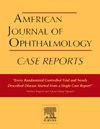The use of trypan blue to distinguish Pseudo-Seidel sign from lacrimal ductule versus glaucoma drainage device leakage
Q3 Medicine
引用次数: 0
Abstract
Introduction
The superotemporal fornix location of the lacrimal gland ductule openings coincides with the typical locations of glaucoma drainage devices; as a result, a conjunctival fistula may look and behave like a lacrimal gland ductule. External morphology and Seidel test are helpful in identifying fluid flow but cannot differentiate the fluid as aqueous humor or tears. We describe a novel technique in differentiating a lacrimal gland ductule from a conjunctival fistula secondary to a glaucoma drainage device.
Case presentation
An 87-year-old female with a superotemporal Ahmed valve in the right eye presented with increased “tearing” over the past year, with concern for repeat tube exposure versus normal secretion from the lacrimal gland ductules. Difficulty in differentiation was further increased due to a regional conjunctival pedicled flap for previous tube exposure. Intra-operatively, trypan blue was injected into the anterior chamber of the right eye. The dye was visualized to track along the tube in the direction of the plate, and brisk flow was then observed at the conjunctival area of ambiguity. This confirmed that fluid leakage was due to a glaucoma drainage device-associated conjunctival fistula. The plate and tube were subsequently removed.
Conclusions
Intraocular injection of trypan blue dye was effective in identifying glaucoma drainage device leakage from tube exposure, and specifically allowing clear differentiation from physiologic lacrimal gland flow. This novel technique successfully differentiated a leaking conjunctival fistula requiring treatment from a benign physiologic finding, in a case where topical fluorescein testing was not sufficient.
台盼蓝鉴别泪道小管伪赛德尔征与青光眼引流器渗漏
泪腺小管开口的颞上穹窿位置与青光眼引流装置的典型位置重合;因此,结膜瘘管的外观和行为可能与泪腺小管相似。外部形态学和赛德尔试验有助于鉴别液体流动,但不能区分液体是房液还是泪液。我们描述了一种区分泪腺小管和结膜瘘管继发于青光眼引流装置的新技术。病例表现:87岁女性右眼颞上艾哈迈德瓣膜,在过去的一年里出现了更多的“流泪”,与重复的导管暴露相比,泪腺小管分泌正常。由于先前的管暴露,局部结膜带蒂皮瓣进一步增加了分化的困难。术中右眼前房注入台盼蓝。染色沿管沿板方向可见,然后在结膜模糊区观察到轻快的流动。这证实了液体渗漏是由于青光眼引流装置相关的结膜瘘。随后取出板和管。结论眼内注射台盼蓝染料可有效鉴别青光眼引流管外露引起的渗出性青光眼,并可明确与生理性泪腺流动的鉴别。在局部荧光素检测不充分的情况下,这种新技术成功地将需要治疗的漏性结膜瘘与良性生理发现区分开来。
本文章由计算机程序翻译,如有差异,请以英文原文为准。
求助全文
约1分钟内获得全文
求助全文
来源期刊

American Journal of Ophthalmology Case Reports
Medicine-Ophthalmology
CiteScore
2.40
自引率
0.00%
发文量
513
审稿时长
16 weeks
期刊介绍:
The American Journal of Ophthalmology Case Reports is a peer-reviewed, scientific publication that welcomes the submission of original, previously unpublished case report manuscripts directed to ophthalmologists and visual science specialists. The cases shall be challenging and stimulating but shall also be presented in an educational format to engage the readers as if they are working alongside with the caring clinician scientists to manage the patients. Submissions shall be clear, concise, and well-documented reports. Brief reports and case series submissions on specific themes are also very welcome.
 求助内容:
求助内容: 应助结果提醒方式:
应助结果提醒方式:


